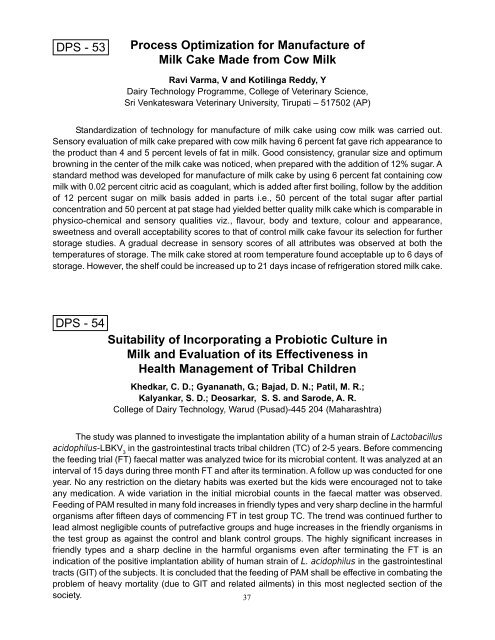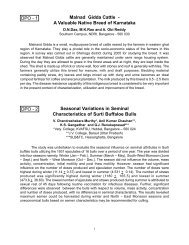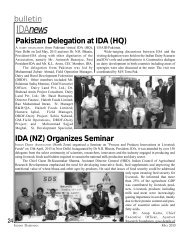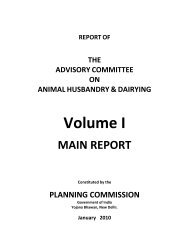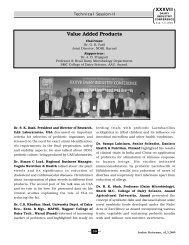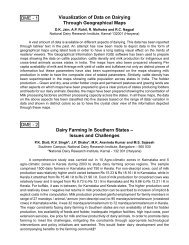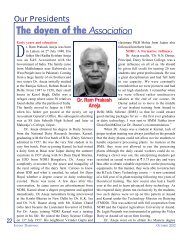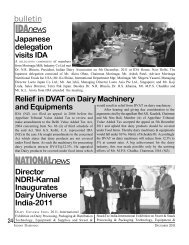Prevalence of Antibiotic Resistance in Dairy Strains of Streptococcus ...
Prevalence of Antibiotic Resistance in Dairy Strains of Streptococcus ...
Prevalence of Antibiotic Resistance in Dairy Strains of Streptococcus ...
You also want an ePaper? Increase the reach of your titles
YUMPU automatically turns print PDFs into web optimized ePapers that Google loves.
DPS - 53Process Optimization for Manufacture <strong>of</strong>Milk Cake Made from Cow MilkRavi Varma, V and Kotil<strong>in</strong>ga Reddy, Y<strong>Dairy</strong> Technology Programme, College <strong>of</strong> Veter<strong>in</strong>ary Science,Sri Venkateswara Veter<strong>in</strong>ary University, Tirupati – 517502 (AP)Standardization <strong>of</strong> technology for manufacture <strong>of</strong> milk cake us<strong>in</strong>g cow milk was carried out.Sensory evaluation <strong>of</strong> milk cake prepared with cow milk hav<strong>in</strong>g 6 percent fat gave rich appearance tothe product than 4 and 5 percent levels <strong>of</strong> fat <strong>in</strong> milk. Good consistency, granular size and optimumbrown<strong>in</strong>g <strong>in</strong> the center <strong>of</strong> the milk cake was noticed, when prepared with the addition <strong>of</strong> 12% sugar. Astandard method was developed for manufacture <strong>of</strong> milk cake by us<strong>in</strong>g 6 percent fat conta<strong>in</strong><strong>in</strong>g cowmilk with 0.02 percent citric acid as coagulant, which is added after first boil<strong>in</strong>g, follow by the addition<strong>of</strong> 12 percent sugar on milk basis added <strong>in</strong> parts i.e., 50 percent <strong>of</strong> the total sugar after partialconcentration and 50 percent at pat stage had yielded better quality milk cake which is comparable <strong>in</strong>physico-chemical and sensory qualities viz., flavour, body and texture, colour and appearance,sweetness and overall acceptability scores to that <strong>of</strong> control milk cake favour its selection for furtherstorage studies. A gradual decrease <strong>in</strong> sensory scores <strong>of</strong> all attributes was observed at both thetemperatures <strong>of</strong> storage. The milk cake stored at room temperature found acceptable up to 6 days <strong>of</strong>storage. However, the shelf could be <strong>in</strong>creased up to 21 days <strong>in</strong>case <strong>of</strong> refrigeration stored milk cake.DPS - 54Suitability <strong>of</strong> Incorporat<strong>in</strong>g a Probiotic Culture <strong>in</strong>Milk and Evaluation <strong>of</strong> its Effectiveness <strong>in</strong>Health Management <strong>of</strong> Tribal ChildrenKhedkar, C. D.; Gyananath, G.; Bajad, D. N.; Patil, M. R.;Kalyankar, S. D.; Deosarkar, S. S. and Sarode, A. R.College <strong>of</strong> <strong>Dairy</strong> Technology, Warud (Pusad)-445 204 (Maharashtra)The study was planned to <strong>in</strong>vestigate the implantation ability <strong>of</strong> a human stra<strong>in</strong> <strong>of</strong> Lactobacillusacidophilus-LBKV 3<strong>in</strong> the gastro<strong>in</strong>test<strong>in</strong>al tracts tribal children (TC) <strong>of</strong> 2-5 years. Before commenc<strong>in</strong>gthe feed<strong>in</strong>g trial (FT) faecal matter was analyzed twice for its microbial content. It was analyzed at an<strong>in</strong>terval <strong>of</strong> 15 days dur<strong>in</strong>g three month FT and after its term<strong>in</strong>ation. A follow up was conducted for oneyear. No any restriction on the dietary habits was exerted but the kids were encouraged not to takeany medication. A wide variation <strong>in</strong> the <strong>in</strong>itial microbial counts <strong>in</strong> the faecal matter was observed.Feed<strong>in</strong>g <strong>of</strong> PAM resulted <strong>in</strong> many fold <strong>in</strong>creases <strong>in</strong> friendly types and very sharp decl<strong>in</strong>e <strong>in</strong> the harmfulorganisms after fifteen days <strong>of</strong> commenc<strong>in</strong>g FT <strong>in</strong> test group TC. The trend was cont<strong>in</strong>ued further tolead almost negligible counts <strong>of</strong> putrefactive groups and huge <strong>in</strong>creases <strong>in</strong> the friendly organisms <strong>in</strong>the test group as aga<strong>in</strong>st the control and blank control groups. The highly significant <strong>in</strong>creases <strong>in</strong>friendly types and a sharp decl<strong>in</strong>e <strong>in</strong> the harmful organisms even after term<strong>in</strong>at<strong>in</strong>g the FT is an<strong>in</strong>dication <strong>of</strong> the positive implantation ability <strong>of</strong> human stra<strong>in</strong> <strong>of</strong> L. acidophilus <strong>in</strong> the gastro<strong>in</strong>test<strong>in</strong>altracts (GIT) <strong>of</strong> the subjects. It is concluded that the feed<strong>in</strong>g <strong>of</strong> PAM shall be effective <strong>in</strong> combat<strong>in</strong>g theproblem <strong>of</strong> heavy mortality (due to GIT and related ailments) <strong>in</strong> this most neglected section <strong>of</strong> thesociety.37


